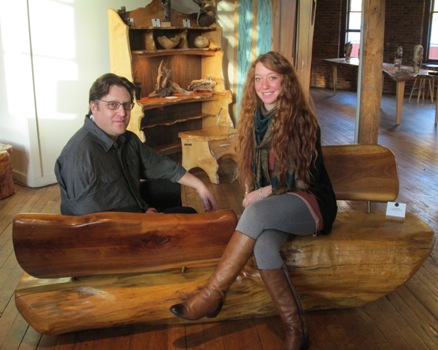 Owner Jordan Schlanger and co-worker Caitlyn Schomaker on Jesse Reimer’s “Mother-Daughter” bench
Owner Jordan Schlanger and co-worker Caitlyn Schomaker on Jesse Reimer’s “Mother-Daughter” bench
Housatonic is a study in contrasts. In this Berkshire town, brick mill houses and graffitied trains long out of service nestle alongside a gushing river and hills flocked with trees. “It’s real country out here,” says Jordan Schlanger, a sculptor and jewelry designer who opened the home design gallery Art et Industrie on the second floor of a former textile mill this July. “But in this little valley, it’s this industrial, post-apocalyptic, crumbling Soho mill scene.”
That’s perfect for Art et Industrie, which showcases home décor at the crossroads of nature and manufacturing. Its inaugural show, with more than 200 designs by 20 regional artisans, features works exclusively made from reclaimed and salvaged materials — from antique shovels and wind-fallen maples to wood ripped from Coney Island’s boardwalks.
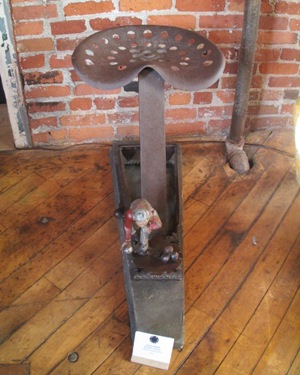 The results are a testament to eco-friendly ingenuity. Warren Barber, a Becket craftsman, scored the cedar fencepost that he shaped into a lamp ($2100) from Sheffield’s farmlands. Woodstock’s Jesse Reimer often goes dumpster-diving to create works like “Grandpa’s Secret,” a chair fashioned from an iron tractor seat and a bowler figurine from a Coney Island arcade ($1500). Pull a lever at the chair’s bluestone base, and the bowler juts forward, aiming for a strike.
The results are a testament to eco-friendly ingenuity. Warren Barber, a Becket craftsman, scored the cedar fencepost that he shaped into a lamp ($2100) from Sheffield’s farmlands. Woodstock’s Jesse Reimer often goes dumpster-diving to create works like “Grandpa’s Secret,” a chair fashioned from an iron tractor seat and a bowler figurine from a Coney Island arcade ($1500). Pull a lever at the chair’s bluestone base, and the bowler juts forward, aiming for a strike.
For Schlanger, blending organic forms with man-made materials scores an aesthetic perfect 10. He first became interested in the 19th-century period when agrarianism met industrialization while restoring Dutch barns in Saugerties. With Art et Industrie, he wants to make that moment new. “The period this mill represents is when people were still working farms,” he says. “Forging and tools were all being used, but they had the sweat and thumbprint of the maker on them.”
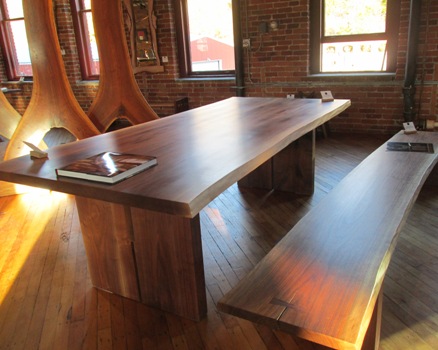 Modern-day artisans have certainly left their imprint on the furniture at Art et Industrie, which begs to be touched. These days Schlanger can’t keep his hands off the smooth black walnut table ($10,700) by Jessica Wickham, a Beacon woodworker. Her five years’ training in Japan shines through in the table’s asymmetric lines and rough edges, which are hallmarks of wabi-sabi—a principle that embraces the beauty of imperfection. “She has very quiet details; no ego,” Schlanger says, pointing out the sliding dovetail joinery on Wickham’s nesting stools ($1625).
Modern-day artisans have certainly left their imprint on the furniture at Art et Industrie, which begs to be touched. These days Schlanger can’t keep his hands off the smooth black walnut table ($10,700) by Jessica Wickham, a Beacon woodworker. Her five years’ training in Japan shines through in the table’s asymmetric lines and rough edges, which are hallmarks of wabi-sabi—a principle that embraces the beauty of imperfection. “She has very quiet details; no ego,” Schlanger says, pointing out the sliding dovetail joinery on Wickham’s nesting stools ($1625).
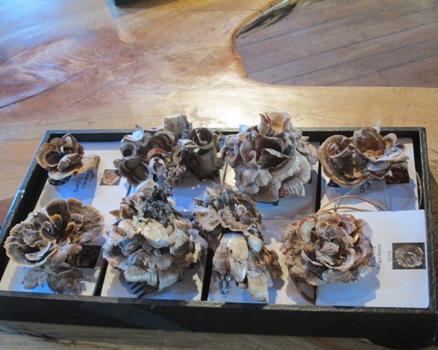 The mushroom brooches, earrings, and fascinators ($75-$200) that Livingston’s Carole Clark creates from foraged fungi have more razzle-dazzle. With delicately scalloped edges and blooms, her jewelry is both rugged and feminine—and a far cry from the high-end materials Schlanger typically sees in the jewelry business he’s run for more than 20 years. “I was used to pavé diamonds and gold and silver,” Schlanger says. “Carole came to me with fungus earrings, and I was like, ‘Yeah! Absolutely.’”
The mushroom brooches, earrings, and fascinators ($75-$200) that Livingston’s Carole Clark creates from foraged fungi have more razzle-dazzle. With delicately scalloped edges and blooms, her jewelry is both rugged and feminine—and a far cry from the high-end materials Schlanger typically sees in the jewelry business he’s run for more than 20 years. “I was used to pavé diamonds and gold and silver,” Schlanger says. “Carole came to me with fungus earrings, and I was like, ‘Yeah! Absolutely.’”
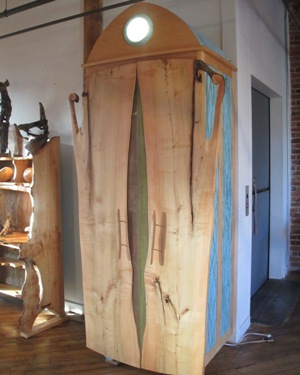 Some pieces seem transported straight from the pages of a fairy tale. Peter Dellert’s ambrosia maple armoire ($4900), made from salvaged firewood, features details such as twig handles, turquoise siding, curlicues, and a softly glowing light. It looks ready to burst open its doors and start singing “Be Our Guest.” Michael King’s pine table ($4000), pierced through with a three-pronged branch, draws inspiration from the enchanted broom of The Sorcerer’s Apprentice.
Some pieces seem transported straight from the pages of a fairy tale. Peter Dellert’s ambrosia maple armoire ($4900), made from salvaged firewood, features details such as twig handles, turquoise siding, curlicues, and a softly glowing light. It looks ready to burst open its doors and start singing “Be Our Guest.” Michael King’s pine table ($4000), pierced through with a three-pronged branch, draws inspiration from the enchanted broom of The Sorcerer’s Apprentice.
Over in what Schlanger calls “the hobbit corner” are friendly, hefty benches that Jesse Reimer shapes from single logs and stones drawn from Hudson Valley creeks. “Mother-Daughter,” a maple base bench with a walnut back ($2000), lets sitters face in opposing directions: ideal for those on the lookout for approaching orcs.
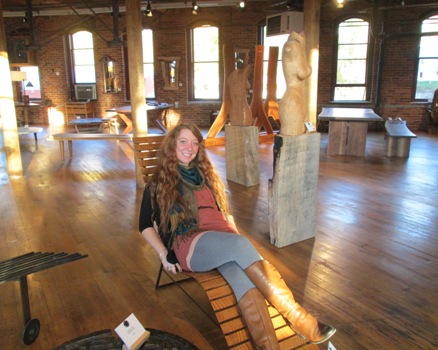 More machine-minded are the manhole cover coffee table ($2185) by Fingerlakes designers Miles and May (“It’s legally acquired,” Schlanger promises) and the abstract paintings ($1600-2800) that Paul Neuman composes from textile mill cards. A slat chaise by John Corcoran ($3170) offers a modern take on beach chairs with maple reclaimed from shipping pallets.
More machine-minded are the manhole cover coffee table ($2185) by Fingerlakes designers Miles and May (“It’s legally acquired,” Schlanger promises) and the abstract paintings ($1600-2800) that Paul Neuman composes from textile mill cards. A slat chaise by John Corcoran ($3170) offers a modern take on beach chairs with maple reclaimed from shipping pallets.
Wondering how to come up with such creative ideas? Try sitting at a creative desk. It would be almost impossible to color inside the lines at Richard Johnson’s wavering “Dear Diary” desk ($5800). Jason Rosky’s claro walnut console table ($5800) has a live edge that could double as a worry groove for workers brainstorming their next big ideas.
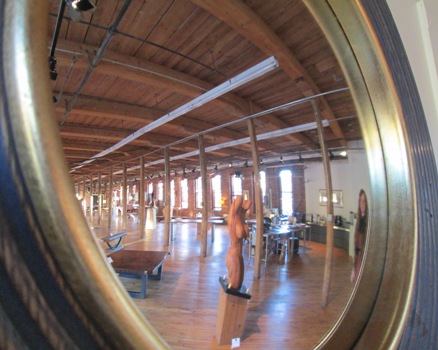 As for big ideas, Schlanger’s got plenty. A New Rochelle native who moved to Housatonic a year ago after long-term stints in New York City and Saugerties, he’s pumped to be a part of his new town’s thriving arts scene. He’ll be expanding on his love for all things reclaimed with the upcoming winter show Art and Artifact, which will feature scavenged iron and steel factory parts. “They’re just as valid as any sculpture,” Schlanger says, “things people can put in their homes and which will enrich them by their history and craft.”
As for big ideas, Schlanger’s got plenty. A New Rochelle native who moved to Housatonic a year ago after long-term stints in New York City and Saugerties, he’s pumped to be a part of his new town’s thriving arts scene. He’ll be expanding on his love for all things reclaimed with the upcoming winter show Art and Artifact, which will feature scavenged iron and steel factory parts. “They’re just as valid as any sculpture,” Schlanger says, “things people can put in their homes and which will enrich them by their history and craft.”
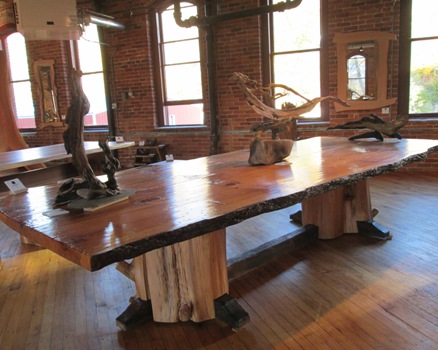 Potential buyers and admirers can scout out the current show through November. Schlanger threatens that some of the grander pieces, like Richard Johnson’s 12-foot-long , rough-hewn “King’s Table,” may be around even longer. “It belongs in a castle,” he says of the table. But in order to reach Camelot, someone would have to figure out how to move it. “We had to bring it up and around through a neighboring mill, through the window, and around the back,” Schlanger says. “It’s never leaving.” —Sarah Todd
Potential buyers and admirers can scout out the current show through November. Schlanger threatens that some of the grander pieces, like Richard Johnson’s 12-foot-long , rough-hewn “King’s Table,” may be around even longer. “It belongs in a castle,” he says of the table. But in order to reach Camelot, someone would have to figure out how to move it. “We had to bring it up and around through a neighboring mill, through the window, and around the back,” Schlanger says. “It’s never leaving.” —Sarah Todd